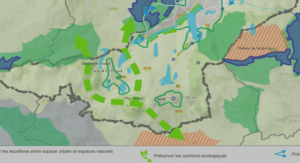First described in Uganda in 1937 (Smithburn 1940), West Nile virus (WNV) is responsible for infections in humans and horses, the virus has a transmission cycle involving mosquitoes as vectors and birds as amplifying hosts (Work et al. 1955, Taylor et al. 1956). For a long time, WN disease was endemic in the Middle East and Africa with sporadic outbreaks reported in Asia and Europe; so that it was not expected that the disease would reach the Western Hemisphere and cause death of many humans, horses and birds (Murgue et al. 2002). In Europe, several outbreaks have recently occurred in horses and humans in different countries including Romania (1996, 2010), Italy (1998, 2011), Russia (1999, 2007) and France (2000, 2003, 2004) (Hubalek & Halouzka 1999a, Murgue et al. 2002, Platonov et al. 2008, Bagnarelli et al. 2011). Since its introduction in North America (CDC 1999), WNV is recognized as the most widespread of the flaviviruses, with worldwide distribution.
Infection with WNV shows different effects on the hosts. Most infected hosts have no symptoms. A few percentages of infected individuals develop mild flu like symptoms. Neuroinvasive disease rarely occurs, however, is the acute form of WNV infection in humans and horses. It is estimated that about 20% of people who become infected will develop WN fever with mild symptoms, including fever, headache, myalgia, and occasionally a skin rash on the trunk of the body. About 1 of 150 WNV infections (<1%) result in meningitis or encephalitis. Case fatality rates among patients hospitalized during recent outbreaks have ranged from 4% to 14%. (Petersen & Marfin 2002). The infected birds may or may not become ill. Birds generally do not have symptoms of West Nile until the virus has caused encephalitis, or inflammation of the brain. Some bird species, like crows, showed a high susceptibility with death during WNV outbreaks in the US (Eidson et al. 2001).
Even if the epidemiology remains unclear, birds are known to take part in various aspects of WNV circulation (McLean et al. 2001, Malkinson & Banet 2002). Several studies have proved the essential role of birds as reservoir and spreader of WNV (Reed et al. 2003, Jourdain et al. 2007). Iran has « important wetlands », which support large breeding populations of many species of birds; in addition, each year, millions of birds coming from different countries migrate to these areas to pass the winter or use them as staging areas on their way to and from wintering areas. Iran appears to be a privileged area for the WNV transmission cycle. Likewise, the objective in this study is to identify the biotic and abiotic factors involved in the circulation, transmission maintenance and spreading, of WNV in the environment.
Geographic dissemination of WNV
West Nile virus belongs to the Flaviviridae family, flavivirus genus. The viruses belonging to this family possess a single strand, positive-sense RNA genome. Within Flavivirus genus, based on cross-neutralization and molecular genetics, WNV is classified within the Japanese Encephalitis serological complex (Kuno et al. 1998). WNV is currently distributed in many parts of the world. The virus was first recognized in 1937 after it was isolated from the blood of a febrile woman in the West Nile District of Uganda (Smithburn 1940). Since then, it has been reported from the Middle East, Africa, Europe, Asia, Australia and from American countries (Hayes 2001).
Worldwide circulation of WNV
In South Africa, the first evidence of WNV was documented in 1958. The largest human outbreak of the disease was reported in 1974, which involved tens of thousands of human cases in the Karoo and Northern Cape Provinces (Murgue et al. 2002). The first report of WNV in Europe was the detection of specific virus antibodies in Albania in 1958 (Bardos et al. 1959). In France, the first outbreaks of WNV occurred in the south, in 1962, with several nervous system abnormalities reported in the Carmargue region in humans and horses. The region is characterized by wetlands and marshes, with a great number of migratory and resident bird species and large populations of mosquitoes (Hubalek & Halouzka 1999a, Murgue et al. 2001b). After 38 years, another outbreak of WN disease was reported in horse population in southern France in 2000. During this outbreak, 76 of 131 equines with neurologic disorders were laboratory-confirmed; most of the cases were located in a region with large marshes (Murgue et al. 2001b). In Italy, during the late summer in 1998, an outbreak of neurologic disease occurred among horses residing in a large wetland area. The case-fatality rate of this outbreak (43%) was similar to the outbreak in 2000 in France (34%) (Autorino et al. 2002). In 2008, the WNV infection re-emerged in Italy; the isolated strains of these outbreaks (1998/ 2008) felt in the same sub-cluster with the isolates from Romania and Russia (Savini et al. 2008). However, phylogenetic tree analysis of the complete genome sequence of WNV strains isolated in 2009 in Italy showed that the strains were closely related to the two WNV strains isolated from magpies in Italy in 2008. The 2008-2009 Italian WNV isolates had a higher degree of divergence from the eastern European strains isolated in Romania in 1996 and in Russia in 1999 and from the American/Israeli cluster (Barzon et al. 2009). In 1996, 94 equines were affected in Morocco; 42 of which died. WN disease was reported in all age categories and it caused a higher mortality rate (45%) than the other almost concurrent outbreaks. There was a silent period until 2003, when an outbreak of WNV occurred again among stabled horses. Based on phylogenetic analyses, the virus isolates of Morocco in 2003 were similar to the 1996 isolate and to other strains responsible for equine outbreaks in the western Mediterranean basin. Recently an outbreak of WNV has been reported in horses in Centre region in Morocco (Schuffenecker et al. 2005, GAH 2010). Since the outbreak of WNV in France, there have been several reports of West Nile virus activity in other European countries such as Spain (in the 1960s and the 1980s, 2010, 2011) and Austria (1960s and 70s). The activity or outbreaks of the virus have been detected in Portugal, Italy, Greece, Bulgaria, Romania, Hungary, Slovakia, Belarus, Ukraine, and Czech Republic (Hubalek & Halouzka 1999a, Samoilova et al. 2003, Esteve et al. 2005, Hubalek et al. 2006, Krisztalovics et al. 2008, Barros et al. 2011, Danis et al. 2011, GarciaBocanegra et al. 2011, Lelli et al. 2011). In 1996, the most serious European outbreak of WNV occurred in Romania where the first activity of the virus dated back to the 1960s (Campbell et al. 2001). Between July and October 1996, 835 patients were hospitalized with suspected central nervous system infection. Among 509 patients with samples for testing, 393 (77%) were laboratoryconfirmed to have WN virus antibodies, including 286 from Bucharest. There were 17 fatalities (4·3%) in patients older than 50 years (Tsai et al. 1998). Currently there is no evidence that WNV causes disease in the UK, nevertheless in 2003, Buckley et al. reported the presence of virus-specific neutralizing antibodies to WNV (22.7 %) in the sera collected from 30 different species of wild or farm birds (resident and migrant birds) in the UK (Cambridgeshire, Dorset and south Wales), implying that the virus was being introduced to UK birds, possibly by mosquitoes. It seemed that the virus is being introduced into UK-resident birds, apparently without causing any obvious reduction in the bird population. In addition, other activities included surveillance for WNV infections in humans, and in dead birds, mosquitoes and horses, carried out between 2001 and 2005, have found no positive cases of UK-acquired WNV. Between 2001 and 2006, tissue samples were collected from over 1800 wild birds by the laboratories of SAC in Scotland and the Veterinary Laboratories Agency (VLA) in England and Wales. The samples were tested by VLA for the presence of WNV by virus isolation and PCR. No evidence of WNV infection was found (Buckley et al. 2003, Morgan 2006, Pennycott & Cert 2011). In 1999, WNV found its way to North America as an important pathogen and has spread rapidly throughout the country, presenting a threat to both human and animal health. During this outbreak, among 62 human cases, 59 (95%) were reported as West Nile meningitis or encephalitis (neuroinvasive disease), 3 (5%) were reported as West Nile fever (milder disease) and seven patients died (CDC 2007). The case fatality rate for horses in New York was 25% and thousands of birds of as many as 18 species died during this outbreak (Steele et al. 2000). In the later years WNV continued to cause disease in humans, horses, and a variety of bird species in New York City and within several years, it became firmly established in U.S and gradually made its way to Latin America, the Caribbean and Canada (Komar et al. 2003b, Mattar et al. 2005). In Canada, the first reports of WN virus activity were notified in 2001 when the virus was found in dead birds and mosquito pools in Southern Ontario and the first human and horse cases were confirmed in the following year, 2002 (Weese et al. 2003). The source of virus introduction to North America is unknown; potential sources include an infected vector, human, bird, or other vertebrate hosts (Lanciotti et al. 1999). The close genetic relationship between WN virus isolates from Israel and New York suggests that the virus was imported into North America from the Middle East (Lanciotti et al. 1999). Overall, we can classify epidemic and/or epizootic occurrence of WNV to two distinct periods: before 1990 and after 1990. The years after 1990 apparently have had suitable conditions for the circulation of the virus as a higher occurrence of disease among human, horse and bird population has been reported in these years ( Figure 1). Circulation of WNV, like other vector borne-diseases, is so dependent on the climate and the difference between two parts of time can be related to the global climate change. A millennial study (1000-2000) of climate change has revealed that the 1990s was the warmest decade and 1998 the warmest year (Jones 2000).
Geographical distribution of the lineages
Evidence from phylogenetic studies suggests that there are at least eight genetic lineages of WN virus:
– Lineage 1: these strains have a broad geographical distribution, isolated from over 20 countries. The viruses within this lineage are divided into two clades:
– 1a: the viruses isolated from Europe, Africa (north, West, central), India, Asia, Middle East and the United States;
– 1b: the virus isolated in Australia, also known as Kunjin virus (KUNV). Most virulent viruses in recent outbreaks belong to clade 1a; however, the lineage contains both virulent and attenuated viruses,
– Lineage 2: mainly comprised of virus isolates from endemic areas of west, central and east Africa and Madagascar; although some strains have been found outside Africa. These viruses often cause asymptomatic infections or mild disease, but virulent viruses also exist. One virulent virus has caused encephalitis in raptors in Central Europe (Hungary) (Berthet et al. 1997, Lanciotti et al. 1999, Savage et al. 1999, Lanciotti et al. 2002). Recently it has been shown that WNV lineage 2 may cause neurologic disease in horses in southern Africa and in Hungary (Venter et al. 2009, Kutasi et al. 2011),
– Lineage 3: includes the isolates from Culex pipens at the Czech Republic/ Austria border (Rabensburg virus),
– Lineage 4: the isolate from Dermacentor marginatus ticks in the Caucasus Mountain valley, Russia (LEIV-Krnd88-190) makes this lineage (Prilipov et al. 2002, Bakonyi et al. 2005),
– Lineage 5: The Indian isolates had been placed previously within lineage 1 as a separate cluster (clade 1c), but more analyses of genome sequences have classified them as lineage 5 (Bondre et al. 2007).
– Lineage 6: this lineage has been proposed for the Sarawak Kunjin virus strain (Malaysian isolate), which is markedly different from the other Kunjin viruses.
– Lineage 7: African Koutango virus (isolated in Senegal), which is closely related to WNV
– Lineage 8: this lineage has been proposed on the basis of WNV sequences detected in Cx. pipiens captured in southern Spain (Vazquez et al. 2010, Papa et al. 2011).
WNV Circulation in the Middle East
The Middle East is geographically well known as an area where intense migratory activity of birds can be observed during the year. This region is considered as a cross road for the bird species that stop over between Europe and Africa.
Egypt- The first documents about the virus activity and its characteristics are related to the studies in Egypt, where the first epidemiological studies of WN fever have been conducted in the 1950s. Sero-epidemiological surveys in humans, mammals and birds as well as entomological studies carried out at that time characterized the ecology of the virus and the endemicity of WNV in Egypt (Melnick et al. 1951, Hurlbut et al. 1956, Murgue et al. 2002). The results from an endemic area in the Nile Delta suggested that WN infection is essentially a childhood disease, taking place mainly during mid-summer. Although there were no data on the symptomatology of the infection, it appeared that the infection was mostly self-limited, non-fatal febrile disease rarely associated with manifestations of encephalitis (Taylor et al. 1956). Another study was carried out in 1968, among 120 children, attending the fever hospital in Alexandria and complaining of fever. It was noted that although the sera were collected during June to October, all positive sera were obtained in August (Mohammed et al. 1970) .
GENERAL INTRODUCTION |






